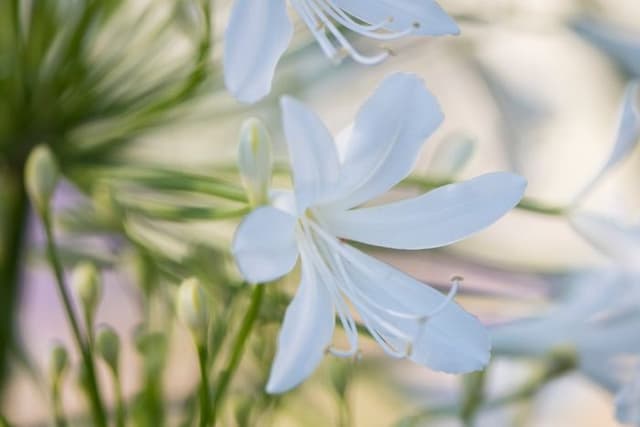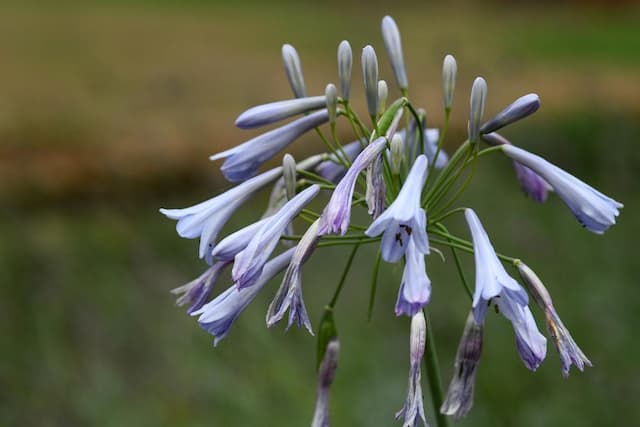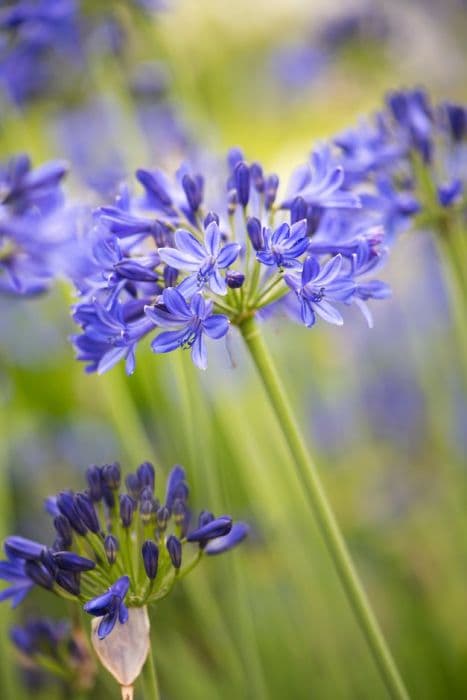African Lily Agapanthus 'Oslo'

ABOUT
Agapanthus 'Oslo' is a perennial plant known for its striking blooms and attractive foliage. Commonly referred to as African Lily or Lily of the Nile, it showcases lush, strap-like green leaves that gracefully arch outwards, forming a lush, dense mound of foliage at the base. The greenery provides a beautiful contrast to the flowers that emerge atop long, slender stalks. The most captivating feature of Agapanthus 'Oslo' are its flower clusters. Each stalk is crowned by a large, rounded umbel composed of multiple individual trumpet-shaped flowers. These flowers are typically a deep blue or violet color, though some cultivated varieties may exhibit different hues such as white or lighter shades of blue. The petals are soft and slightly recurved, lending a delicate appearance to the otherwise hardy plant. Once in bloom, the African Lily becomes a focal point in any garden, drawing attention with its vivid color and bold, globe-like floral displays. The blooms are not only visually stunning but are also known to attract pollinators such as bees and butterflies, adding to the plant's allure and its role in the garden ecosystem. The overall appearance of Agapanthus 'Oslo' exudes a tropical appeal, though the plant is quite versatile and can thrive in a variety of climates, provided it is cared for properly. With its lush greenery and captivating flowers, the African Lily makes an excellent addition to borders, beds, and as a striking container plant, where its exceptional beauty can be fully admired.
About this plant
 Names
NamesFamily
Amaryllidaceae
Synonyms
African Lily, Lily of the Nile, Love Flower
Common names
Agapanthus 'Oslo'
 Toxicity
ToxicityTo humans
The Agapanthus, commonly known as the Lily of the Nile, has components that are considered toxic if ingested. Human poisoning can occur, particularly if the sap or parts of the plant are eaten. The symptoms of poisoning from Agapanthus can include nausea, vomiting, diarrhea, and abdominal pain. It is important to avoid ingesting any part of the plant to prevent these potential consequences.
To pets
The Lily of the Nile can be toxic to pets if ingested. The plant contains substances that can cause vomiting, nausea, and diarrhea in animals such as cats and dogs. Ingesting this plant can also potentially lead to drooling and other signs of gastrointestinal distress. Pet owners should ensure that their pets do not eat any part of the Agapanthus plant to avoid these adverse effects.
 Characteristics
CharacteristicsLife cycle
Perennials
Foliage type
Evergreen
Color of leaves
Green
Flower color
Blue
Height
2 feet (0.6 meters)
Spread
2 feet (0.6 meters)
Plant type
Bulb
Hardiness zones
8
Native area
South Africa
Benefits
 General Benefits
General Benefits- Ornamental Appeal: Agapanthus 'Oslo', commonly known as Lily of the Nile, features striking blue or violet flower clusters that add aesthetic value to gardens and landscapes.
- Drought Tolerance: Once established, Lily of the Nile is quite drought-resistant, making it suitable for water-wise gardening.
- Low Maintenance: This plant requires minimal care, making it a convenient choice for busy gardeners.
- Attracts Pollinators: The blooms of Lily of the Nile attract bees, butterflies, and other beneficial pollinators to the garden.
- Long Blooming Period: It offers a long flowering season, providing color and interest from late spring through summer.
- Versatility: Lily of the Nile can be used in various garden settings, such as borders, container gardens, and as cut flowers for arrangements.
 Medical Properties
Medical PropertiesThis plant is not used for medical purposes.
 Air-purifying Qualities
Air-purifying QualitiesThis plant is not specifically known for air purifying qualities.
 Other Uses
Other Uses- Agapanthus, known as the Lily of the Nile, can be used as a natural fabric dye, offering hues ranging from soft lavenders to deep blues depending on the mordant used.
- In floral art, the sturdy stems and eye-catching blooms of the Lily of the Nile are often used in Ikebana, the Japanese art of flower arrangement.
- The Lily of the Nile's leaves can be woven into small baskets or decorative items, taking advantage of their length and fibrous nature.
- The ample and bushy shape of the plant is ideal for creating living fences or privacy screens in gardens.
- The nectar-rich flowers of Lily of the Nile attract pollinators such as bees and butterflies, making them an excellent choice for a pollinator-friendly garden.
- Lily of the Nile can be planted around water features like ponds or fountains to add vertical accents and a tropical flair.
- Dried Lily of the Nile seed pods can be used in dried floral arrangements or as unique additions to wreaths and other crafts.
- They can serve as a tool for teaching botany and hybridization due to their easy-to-follow seed pod development and cross-breeding potential.
- The fibrous roots of Lily of the Nile can help stabilize soil and prevent erosion on slopes or in areas prone to washing out with heavy rains.
- Lily of the Nile can be used as a subject in photography classes or workshops, thanks to their striking flowers and the way they play with light.
Interesting Facts
 Feng Shui
Feng ShuiThe Lily of the Nile is not used in Feng Shui practice.
 Zodiac Sign Compitability
Zodiac Sign CompitabilityThe Lily of the Nile is not used in astrology practice.
 Plant Symbolism
Plant Symbolism- Love Letters: The name Agapanthus is derived from the Greek 'agapē' meaning love, and 'anthos' meaning flower. Thus, it is often associated with love and can represent a message of love or a love letter.
- Beauty: With its striking blue, funnel-shaped flowers, Agapanthus embodies beauty, grace, and a unique visual appeal that can symbolize attractiveness and elegance.
- Endurance: Known for its ability to thrive with minimal care and withstand tough conditions, Agapanthus can represent resilience, strength, and endurance in the face of adversity.
- Fertility: Due to its lush foliage and abundant blooms, the plant can also be seen as a symbol of fertility and creation.
- Good Fortune: In some cultures, Agapanthus is believed to bring good fortune and is planted in gardens to attract positive energy.
 Water
WaterAfrican Lily, commonly known as Agapanthus 'Oslo', prefers regular watering to maintain evenly moist soil, especially during its active growing season in spring and summer. It should be watered thoroughly once the top inch of soil feels dry, typically about once a week, with adjustments made for rainfall and temperature. Provide the plant with approximately one-inch of water each week, which equates to about 0.62 gallons for a medium-sized pot. In the winter, reduce watering to every other week or less, depending on indoor air humidity and temperature, ensuring the soil does not dry out completely.
 Light
LightAfrican Lily thrives in full sun to partial shade conditions. The best spot for the plant is where it can receive at least six hours of sunlight a day, though dappled afternoon shade can help protect it during the hottest part of the day in warmer climates. A south-facing garden or a west or east-facing window for potted indoor plants are good locations to provide the light conditions it needs for optimal growth.
 Temperature
TemperatureAfrican Lily does best in temperatures ranging between 50°F and 80°F. The plant can tolerate brief periods of cold down to about 28°F but should be protected from frost to prevent damage. Ideal growth is seen when nighttime temperatures are cooler, around 50°F to 60°F, and daytime temperatures are warmer.
 Pruning
PruningPrune African Lily to remove spent flower stalks and encourage the plant to produce more flowers. Deadheading, or cutting off the faded flowers, should be done as soon as the blooms fade. In late fall or early winter, after flowering has finished, cut back foliage that has died back to tidy up the plant and direct energy to new growth.
 Cleaning
CleaningAs needed
 Soil
SoilAfrican Lily (Agapanthus 'Oslo') thrives in well-draining soil rich in organic matter with a pH of 6 to 7. A mix of loam, compost, and perlite or sand encourages healthy growth. Ensure adequate drainage to prevent water-logging.
 Repotting
RepottingAfrican Lily plants should be repotted every 2 to 3 years or when they become root-bound. Dividing clumps during repotting can help rejuvenate growth and manage plant size.
 Humidity & Misting
Humidity & MistingAfrican Lilies prefer moderate humidity levels but are quite adaptable to different conditions. They do not require high humidity to thrive.
 Suitable locations
Suitable locationsIndoor
Place Lily of the Nile in bright indirect light, ensure good air circulation.
Outdoor
Plant Lily of the Nile in sun to part shade, shelter from harsh conditions.
Hardiness zone
8-11 USDA
 Life cycle
Life cycleThe life of Agapanthus 'Oslo', commonly known as Lily of the Nile, begins with seed germination, which occurs when conditions are warm and moist. The seedlings develop into juvenile plants, forming fleshy roots and strap-like leaves. As it matures, the plant forms a clump of evergreen or deciduous leaves, depending on the climate. Once mature, usually within a few years, it produces tall stalks topped with clusters of trumpet-shaped flowers during summer. After flowering, the plant sets seed capsules if pollinators have been active, and these seeds can be dispersed to grow new plants. In colder climates, Agapanthus 'Oslo' dies back to the ground in winter but re-emerges in spring, continuing its perennial cycle.
 Propogation
PropogationPropogation time
Spring to Summer
The Agapanthus 'Oslo', commonly known as Lily of the Nile, is typically propagated by dividing its clumps. The best time for propagation is in the early spring or late summer when the plant is not actively flowering. To propagate by division, carefully unearth the plant, ensuring as much root as possible is intact. Gently separate the clumps into smaller sections, each with a portion of roots and foliage. These newly divided plants should then be immediately replanted in well-draining soil and watered thoroughly. Within a few weeks, the divisions will establish themselves and start to grow into new, independent plants. This method is favored due to its simplicity and the high success rate of the resulting plants.







![African lily [Brilliant Blue]](/_next/image?url=https%3A%2F%2Fplants-admin.emdemapps.com%2Fimages%2Fplants%2F%2Fimages%2F604b5e3c28e2b.png&w=640&q=75)

